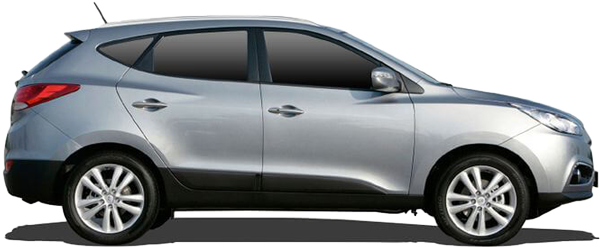The Comparative Analysis :
Nissan Qashqai+2 2.0 dCi 4x4 (10 - 11) vs. Hyundai ix35 Fuel Cell (15 - 18)
€ 29,800

€ 65,500

€ 29,800
Base Price ⓘBase price of a new vehicle with standard equipment in Germany at market launch.
€ 65,500
ⓘBase price of a new vehicle with standard equipment in Germany at market launch. Price Info
Vehicle Dimensions
The dimensions of these vehicles differ slightly. The Nissan Qashqai+2 2.0 dCi is 5.2 inches longer, 1.6 inches narrower and 0.4 inches lower than the Hyundai ix35 Fuel Cell.
Nissan Qashqai+2 2.0 dCi
Hyundai ix35 Fuel Cell
64.8
70.1
78
65.2
71.7
82.7
70.1 in
Width
71.7 in
78 in
Width Incl. Mirrors
82.7 in
64.8 in
Height
65.2 in
108.9
178.8
103.9
173.6
178.8 in
Length
173.6 in
108.9 in
Wheelbase
103.9 in
Vehicle Weight
Nissan Qashqai+2 2.0 dCi
Hyundai ix35 Fuel Cell
3739 lb
Curb Weight
4235 lb
5115 lb
Gross Vehicle
Weight
Weight
4960 lb

Weight Difference:
496 lb
11.71 %

General
Nissan Qashqai+2 2.0 dCi
Hyundai ix35 Fuel Cell
J10
Generation
EL
Sport Utility Vehicle
Car Body Style
Sport Utility Vehicle
Diesel
Fuel Type
Hydrogen

Permanent all-wheel drive (AWD)
Drivetrain
Front-wheel drive

6-speed manual transmission
Transmission
1-speed automatic transmission
Engine
Nissan Qashqai+2 2.0 dCi
Hyundai ix35 Fuel Cell
Straight-four diesel engine with turbocharger
Engine Type
Asynchronous motor
4
Valves
0
4
Cylinders
0
2 L / 98 cu in
Displacement
0 L / 0 cu in
148 hp
at 4000 rpm
Power
134 hp
at 0 rpm
Nissan Qashqai+2 2.0 dCi
148 hp
134 hp
Hyundai ix35 Fuel Cell
236 lb‑ft
at 2000 rpm
Max. Torque
221 lb‑ft
at 0 rpm
Nissan Qashqai+2 2.0 dCi
236 lb‑ft
221 lb‑ft
Hyundai ix35 Fuel Cell
Performance
Nissan Qashqai+2 2.0 dCi
Hyundai ix35 Fuel Cell
119 mph
Maximum Speed
99 mph
10.5 sec
Acceleration 0 to 62 mph
12.5 sec
62 mph
62
mph
mph
479 ft
0.000 sec

Nissan Qashqai+2 2.0 dCi
62 mph
62
mph
mph
571 ft
0.000 sec

Hyundai ix35 Fuel Cell
▶ REPLAY
25.26 lb/hp
Weight-to-Power Ratio
31.6 lb/hp
Nissan Qashqai+2 2.0 dCi
25.26 lb/hp
31.6 lb/hp
Hyundai ix35 Fuel Cell
Fuel Economy / Emissions
Nissan Qashqai+2 2.0 dCi
Hyundai ix35 Fuel Cell
Fuel Economy
38 mpg
( 42 MPGe ⓘ Miles per gallon gasoline equivalent (MPGe) is a measure of the average distance traveled per unit of energy consumed. MPGe, specified in miles per U.S. gallon, is used to compare the energy consumption of vehicles that use different energy sources.)
combined ✽ per 100 miles
1.6 kg H2✽
( 62 MPGe ⓘ Miles per gallon gasoline equivalent (MPGe) is a measure of the average distance traveled per unit of energy consumed. MPGe, specified in miles per U.S. gallon, is used to compare the energy consumption of vehicles that use different energy sources.)
Nissan Qashqai+2 2.0 dCi
42 MPGe
62 MPGe
Hyundai ix35 Fuel Cell
31 mpg
city
1.4 kg H2
44 mpg
highway
1.6 kg H2
17.2 gal
Fuel Tank Capacity
5.6 kg
651 mi
Range
348 mi
Nissan Qashqai+2 2.0 dCi
651 mi
348 mi
Hyundai ix35 Fuel Cell
Environmental Impact
127.6 kWh
Total Energy Consumption
per 100 miles ⓘThe total energy consumption per 100 miles is the amount of energy consumed by a vehicle when burning fuel or using electricity per 100 miles (final energy), and the energy required to produce the appropriate amount of fuel or electricity (primary energy).
per 100 miles ⓘThe total energy consumption per 100 miles is the amount of energy consumed by a vehicle when burning fuel or using electricity per 100 miles (final energy), and the energy required to produce the appropriate amount of fuel or electricity (primary energy).
131.5 kWh
Nissan Qashqai+2 2.0 dCi
127.6 kWh
131.5 kWh
Hyundai ix35 Fuel Cell
Euro 4 / Euro 5
Emission Standard
Brennstoffzelle (Wasserstoff)
262 g/mi (NEFZ)
CO2 Emissions
0 g/mi (NEFZ)
Practical Convenience
Nissan Qashqai+2 2.0 dCi
Hyundai ix35 Fuel Cell
5
Doors
5
7
No. of Seats
5
1376 lb
Maximum Payload
725 lb
3.7 cu ft
Trunk Volume
16.7 cu ft







43 cu ft
Cargo Volume (Seats Down)
40.7 cu ft

















